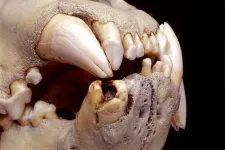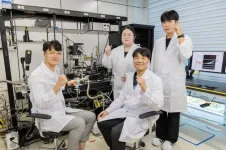(Press-News.org) In a new study, UCLA Health researchers have found that motor delay and low muscle tone were common signs of an underlying genetic diagnosis in children with neurodevelopment disorders.
Given the limited existing data on the early neurodevelopmental symptoms that predict a positive genetic diagnosis, the study authors aimed to research which factors in this subset of children indicated the need of a genetic test. “With genetic testing, a diagnostic result can have benefits on medical care, but we don’t have established clinical guidelines on the early neurodevelopmental signs that classify who gets genetic testing or not”, said Dr. Julian Martinez, study senior co-author and medical geneticist at UCLA Health.
Dr. Martinez said knowing the early neurodevelopment symptoms that signal for a genetic diagnosis can benefit both a patient’s family and doctor: a patient’s family can advocate to see a geneticist, and a geneticist provides testing that can potentially give a positive genetic diagnosis, which can help with monitoring the onset of other medical concerns or provide an opportunity to start a treatment for the specific genetic condition, if one is available.
The study, published in Genetics in Medicine, reviewed medical charts from 316 patients seen at the UCLA Care And Research In NeuroGenetics (CARING) Clinic from 2014-2019. The CARING clinic is a multidisciplinary hub where a psychiatrist, geneticist, neurologist, and psychologist collaborate to treat patients with neurodevelopmental disorders. The patients were categorized based on their genetic testing results, then the researchers documented clinical factors that differentiated patients with and without a genetic diagnosis.
The researchers found that, overall, patients with a genetic diagnosis were more likely to be female and receive early intervention services for a history of motor delay, low muscle tone, and/or congenital heart disease. Of the study group, 75% of patients with motor delay had a genetic diagnosis, and in patients without motor delay, low muscle tone and age of walking were other indicators for a genetic diagnosis.
“For many years, the genetics field has diligently worked on figuring out who are the patients that would benefit the most from genetic testing,” Martinez said. “So, it’s helpful to know that a delay in motor skills yields a very high likelihood of a genetic diagnosis.”
"This study takes us a step closer to developing evidence-based guidelines for genetic testing in neurodevelopmental disorders,” said Dr. Aaron Besterman, study senior author and former UCLA Health Postdoctoral Researcher who’s now a health sciences associate clinical professor at the UCSD Department of Psychiatry. “By identifying key clinical features, we can help ensure that the children most likely to benefit from genetic testing receive it promptly."
Dr. Martinez said that an early genetic diagnosis can lead to managing or anticipating a medical co-occurrence such as congenital heart disease, a psychiatric illness, or information on a higher likelihood of experiencing seizures. He also said while controversial, some families prefer to be informed about their genes for family planning.
“With the use of genetic evaluations and precision medicine, the intent is to shorten the diagnostic odyssey – meaning the long period of time it takes for a patient to receive a diagnosis -- so that we can nurture the patient and provide the personalized care that is best specifically for the patient with a unique diagnosis and not necessarily treat them like anybody else.”
END
Researchers identify neurodevelopmental symptoms that indicate genetic disorders
UCLA Health scientists suggest motor delay and low muscle tone may be clues to prompt genetic testing
2024-10-11
ELSE PRESS RELEASES FROM THIS DATE:
Electronic nudges to increase influenza vaccination in patients with chronic diseases
2024-10-11
About The Study: In a nationwide randomized clinical implementation trial, electronically delivered letter-based nudges markedly increased influenza vaccination compared with usual care among young and middle-aged patients with chronic diseases. The results of this study suggest that simple, scalable, and cost-efficient electronic letter strategies may have substantial public health implications.
Corresponding Author: To contact the corresponding author, Tor Biering-Sorensen, MD, MSc, MPH, PhD, email tor.biering@gmail.com.
To access the embargoed ...
Plant stem cells: Better understanding the biological mechanism of growth control
2024-10-11
Plants form new leaves, flowers and roots at the tips of shoots and roots, in specific growth regions known as meristems. These meristems contain stem cells that divide as needed and form new cells that develop into specialised tissue. Using the example of plant roots, researchers from Freiburg have now been able to decipher which regulatory mechanisms ensure that growth in the meristem occurs in a controlled manner. The results have been published in the journal Nature Plants.
Stem cells are dependent on ...
Genomic study identifies human, animal hair in ‘man-eater’ lions’ teeth
2024-10-11
CHAMPAIGN, Ill. — In 1898, two male lions terrorized an encampment of bridge builders on the Tsavo River in Kenya. The lions, which were massive and maneless, crept into the camp at night, raided the tents and dragged off their victims. The infamous Tsavo “man-eaters” killed at least 28 people before Lt. Col. John Henry Patterson, the civil engineer on the project, shot them dead. Patterson sold the lions’ remains to the Field Museum of Natural History in Chicago in 1925.
In a new study, Field Museum researchers collaborated with scientists at the University of Illinois Urbana-Champaign on an in-depth analysis of hairs carefully extracted ...
These 19th century lions from Kenya ate humans, DNA collected from hairs in their teeth shows
2024-10-11
By isolating and sequencing DNA in compacted hairs collected from the teeth of two Tsavo lion museum specimens from the 1890s, researchers have found that the historic lions from Kenya preyed on a variety of species, including humans, giraffes, and wildebeests. These so-called “Tsavo Man-Eaters” are estimated to have killed at least dozens of people, including those working along the Kenya-Uganda Railway in the late 1890’s. The findings appear in the Cell Press journal Current Biology on October 11.
“As ...
A potential non-invasive stool test and novel therapy for endometriosis
2024-10-11
Promising findings by researchers at Baylor College of Medicine and collaborating institutions could lead to the development of a non-invasive stool test and a new therapy for endometriosis, a painful condition that affects nearly 200 million women worldwide. The study appeared in the journal Med.
“Endometriosis develops when lining inside the womb grows outside its normal location, for instance attached to surrounding intestine or the membrane lining the abdominal cavity. This typically causes bleeding, pain, inflammation and infertility,” said corresponding author Dr. Rama Kommagani, associate professor in the Department of Pathology ...
Racial and ethnic disparities in age-specific all-cause mortality during the COVID-19 pandemic
2024-10-11
About The Study: In this cross-sectional study of the U.S. population during the COVID-19 public health emergency, excess mortality occurred in all racial and ethnic groups, with disparities affecting several minoritized populations. The greatest relative increases occurred in populations ages 25 to 64. Documented differences deviated from pre-pandemic disparities.
Corresponding Author: To contact the corresponding author, Jeremy Samuel Faust, MD, MS, email jsfaust@bwh.harvard.edu.
To access the embargoed study: Visit our For The Media website at this link https://media.jamanetwork.com/
(doi:10.1001/jamanetworkopen.2024.38918)
Editor’s ...
Delft scientists discover how innate immunity envelops bacteria
2024-10-11
Delft scientists discover how innate immunity envelops bacteria
The protein GBP1 is a vital component of our body’s natural defence against pathogens. This substance fights against bacteria and parasites by enveloping them in a protein coat, but how the substance manages to do this has remained unknown until now. Researchers from Delft University of Technology have now unravelled how this protein operates. This new knowledge, published in Nature Structural & Molecular Biology, could aid in the development of medications ...
Workforce diversity is key to advancing One Health
2024-10-11
[Vienna, October 11, 2024] – A new article highlights a critical issue in the One Health approach—an emerging global framework for tackling complex health challenges at the intersection of human, animal, and environmental health. In the article in The Lancet Planetary Health, scientists Amélie Desvars-Larrive and Fariba Karimi from the Complexity Science Hub (CSH) point out that One Health's current framework fails to explicitly address workforce diversity.
According to Desvars-Larrive and Karimi, ...
Genome Research publishes a special issue on innovations in computational biology
2024-10-11
October 11, 2024 – Genome Research (https://genome.org) publishes a special issue highlighting novel advances in computational biology.
In collaboration with the International Conference on Research in Computational Molecular Biology (RECOMB), Genome Research publishes a collection of 20 computational methods and their applications in genomics including spatial, single-cell, and long-read sequencing. These include algorithmic innovations in genomic variation analysis, privacy-preserving algorithms, DNA structural properties, cancer genomics, ...
A quick and easy way to produce anode materials for sodium-ion batteries using microwaves
2024-10-11
The research team led by Dr. Daeho Kim and Dr. Jong Hwan Park at the Nano Hybrid Technology Research Center of the Korea Electrotechnology Research Institute (KERI) has developed a groundbreaking process technology that enables for ultrafast, 30-second preparation of hard carbon anodes for sodium-ion batteries using microwave induction heating.
One of the next-generation secondary batteries, the sodium-ion battery uses sodium (Na) in lieu of the current mainstay, lithium (Li). Sodium, the main component of salt, is more than a thousand times more abundant than lithium and is easier to extract and refine. Furthermore, its lower reactivity compared ...
LAST 30 PRESS RELEASES:
Eye for trouble: Automated counting for chromosome issues under the microscope
The vast majority of US rivers lack any protections from human activities, new research finds
Ultrasound-responsive in situ antigen "nanocatchers" open a new paradigm for personalized tumor immunotherapy
Environmental “superbugs” in our rivers and soils: new one health review warns of growing antimicrobial resistance crisis
Triple threat in greenhouse farming: how heavy metals, microplastics, and antibiotic resistance genes unite to challenge sustainable food production
Earthworms turn manure into a powerful tool against antibiotic resistance
AI turns water into an early warning network for hidden biological pollutants
Hidden hotspots on “green” plastics: biodegradable and conventional plastics shape very different antibiotic resistance risks in river microbiomes
Engineered biochar enzyme system clears toxic phenolic acids and restores pepper seed germination in continuous cropping soils
Retail therapy fail? Online shopping linked to stress, says study
How well-meaning allies can increase stress for marginalized people
Commercially viable biomanufacturing: designer yeast turns sugar into lucrative chemical 3-HP
Control valve discovered in gut’s plumbing system
George Mason University leads phase 2 clinical trial for pill to help maintain weight loss after GLP-1s
Hop to it: research from Shedd Aquarium tracks conch movement to set new conservation guidance
Weight loss drugs and bariatric surgery improve the body’s fat ‘balance:’ study
The Age of Fishes began with mass death
TB harnesses part of immune defense system to cause infection
Important new source of oxidation in the atmosphere found
A tug-of-war explains a decades-old question about how bacteria swim
Strengthened immune defense against cancer
Engineering the development of the pancreas
The Journal of Nuclear Medicine ahead-of-print tip sheet: Jan. 9, 2026
Mount Sinai researchers help create largest immune cell atlas of bone marrow in multiple myeloma patients
Why it is so hard to get started on an unpleasant task: Scientists identify a “motivation brake”
Body composition changes after bariatric surgery or treatment with GLP-1 receptor agonists
Targeted regulation of abortion providers laws and pregnancies conceived through fertility treatment
Press registration is now open for the 2026 ACMG Annual Clinical Genetics Meeting
Understanding sex-based differences and the role of bone morphogenetic protein signaling in Alzheimer’s disease
Breakthrough in thin-film electrolytes pushes solid oxide fuel cells forward
[Press-News.org] Researchers identify neurodevelopmental symptoms that indicate genetic disordersUCLA Health scientists suggest motor delay and low muscle tone may be clues to prompt genetic testing




